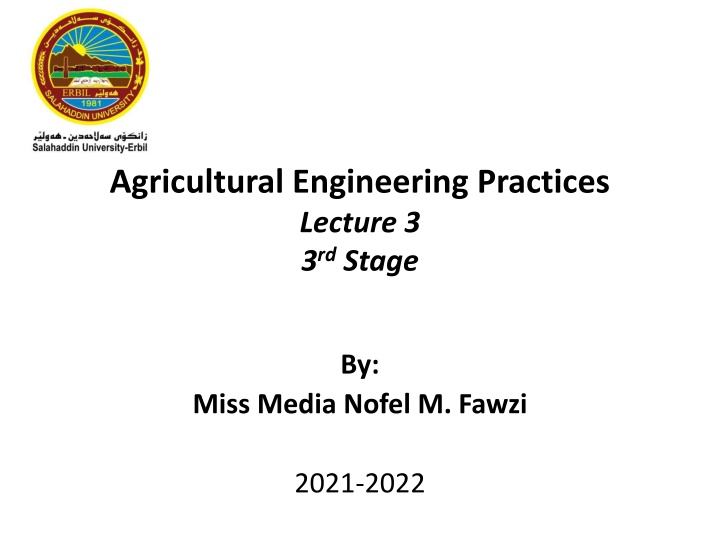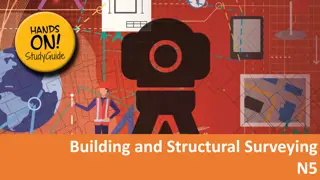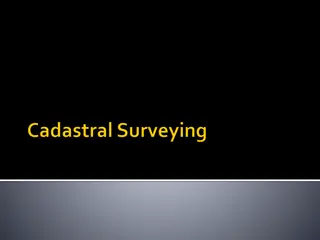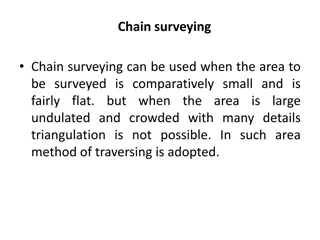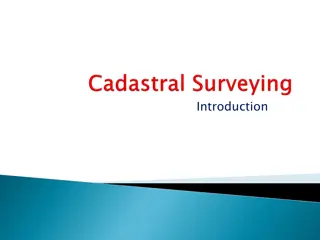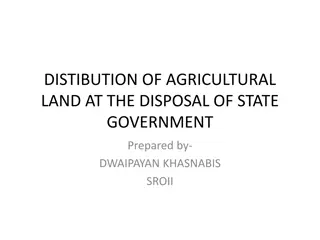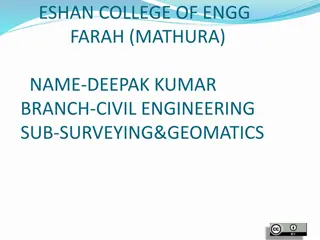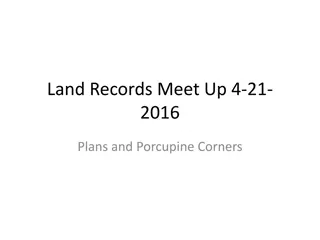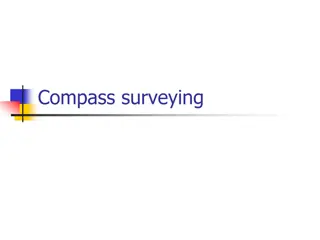Essential Agricultural Land Surveying Practices
Effective farm projects on a mechanized scale start with site selection and survey. Learn about surveying measurements, units, and equipment used in agricultural engineering practices. Understand the importance of land survey in determining relative horizontal and vertical positions for mapping and establishing marks.
Download Presentation

Please find below an Image/Link to download the presentation.
The content on the website is provided AS IS for your information and personal use only. It may not be sold, licensed, or shared on other websites without obtaining consent from the author.If you encounter any issues during the download, it is possible that the publisher has removed the file from their server.
You are allowed to download the files provided on this website for personal or commercial use, subject to the condition that they are used lawfully. All files are the property of their respective owners.
The content on the website is provided AS IS for your information and personal use only. It may not be sold, licensed, or shared on other websites without obtaining consent from the author.
E N D
Presentation Transcript
Agricultural Engineering Practices Lecture 3 3rdStage By: Miss Media Nofel M. Fawzi 2021-2022
Outline of presentation: Introduction to Agricultural Land Surveying Surveying Measurements in survey Units of measurement in survey
Introduction Effective farm project or undertaken on mechanized scale started with site selection and survey. Site selection has to do with making a choice of land based on feasibility studies, soil conditions, topography, physical conditions etc. this can only be authenticated through land survey. Land survey is carried out for the determination of relative horizontal and vertical position, such as that used for the process of mapping and the establishment of marks.
Surveying Webster s dictionary defined surveying as the science of determining the location, form or boundaries of a tract of land by measuring the lines and angles in accordance with the principles of geometry and trigonometry . defined a Surveyor as a professional person with the academic qualification and technical expertise to practice the science of measurement, to assemble and assess land and geographic related information.
Measurements in survey Only four types of measurements are determined thus: 1. Horizontal distance:Horizontal lengths or distances are measured in short, straight sections, which together are practically equivalent to an arc everywhere perpendicular to gravity. 2. Vertical lengths: Vertical lengths or differences in height or elevation measurements are used as reference point. A level surface, with respect to the earth is a curved surface everywhere perpendicular to gravity such as the surface of still water. 3. Horizontal angles:Horizontal angles measured in planes horizontal at the vertex while 4. Vertical angles: These are measured in vertical planes.
Units of measurement in survey The meter is the fundamental unit of length used throughout the world. In 1959 it was agreed by the representatives of the English speaking nations to base the foot on the meter according to the exact ratio 1ft = 0.3048m. Today, the only unit of length used in surveying in addition to metric unit is the foot e.g. (1 station = 100ft). In optical tooling, the inch and decimals of an inch are used exclusively e.g. 20ft = 240in.
Surveying equipment The following are the fundamental surveying instruments required in any survey activity: 1. Steel tape (100-meter): this is the basic means of measuring distance. It consists of graduated steel ribbons or flat wire with handle at each end. Its length is taken as the straight-line distance between the line and marks measured at room temperature, 68 F (20 C).
Surveying equipment 2. Staff: Examples of staff graduation include; metric, upright, E-type, pattern staff. Before using a staff, check the accuracy of the scale using a steel tape because some staff faces may be out by one or more centimeters.
Surveying equipment 3. Wood or aluminum tripod: A wooden tripod is preferred to a metal tripod as it is not subject to as much vibration in windy conditions. The tripod should be long enough to use the instrument without stooping.
Surveying equipment 4. Compass: A compass is a navigational instrument that shows directions in a frame of reference that is stationary relative to the surface of the Earth. The compass can be used to set magnetic north on the level and allow recordings to be taken from it. Two types of compasses are commonly used in survey. These are; Box compasses and circular compasses.
Surveying equipment Box compasses must be used with angle measuring instruments, as they operate only when the line of sights point toward magnetic north. The bearing desired must then be measured from this direction.
Surveying equipment Circular compasses can be mounted on theodolite and are often permanently mounted on transits. When provide with open sights, they can be used alone either mounted on high tripods or held in the hand.
Surveying equipment 5. Pegs/hammer: Pegs, preferably painted white, are required especially for marking out a grid survey or temporary marks. 6. Record/notebook: A notebook is required to record all measurements and other information required to make sense of the survey work completed in the field. 7. Pencil/eraser: A pencil and eraser are preferable to an ink or biro type pen in the field. Mistakes can be easily remedied, pencils will not run out as an ink pen will and a pencil will still function even if the paper becomes a little wet through perspiration.
Surveying equipment 8. Theodolite (transit type): Theodolites are designed to measure or set out both horizontal and vertical angles. It often has a compass for determining magnetic bearings and a spirit level containing a bubble in a liquid attached to the telescope for establishing a horizontal plane and for running levels. The objective lens of the telescope forms an image on the plane of the reticule, where a pattern, etched on glass, or cross hairs mark a point. An eye- piece (ocular) magnifies both the image and the cross hairs so that the observer sees the cross hairs on the object sighted on the line of sight, while the view is magnified about 20 - 30 centimeters.
Theodolite The telescope turns vertically through 360 on a horizontal (elevation) axis established by bearing in two uprights (standards). A graduated vertical circle turns with the telescope past an index on a standard and thus measures vertical angles. The standards are mounted on a horizontal plate, which carries one spirit level, or two at right angles, and usually two indices 180 apart for reading a horizontal graduated circle. The plate is mounted on a vertical spindle that allows it to turn in a horizontal plane about a vertical axis (azimuth axis) and the horizontal axis is adjusted so that it is perpendicular to the vertical axis. The parts so far described are called collectively the alidade.
Theodolite The spindle turns in a bearing at the base or leveling head, and the graduated horizontal circle for measuring horizontal angles turns in a separate bearing also on the leveling head. A clamp and a tangent screw that permits slow motion controls the rotation of the alidade with respect to the level head. The alidade index is set at zero by operating the upper motion. Using the lower motion, the line of sight can be turned to the target that marks the first side of the angle without disturbing the zero setting.
Theodolite When the telescope is turned to the second side or the angle, by means of the upper motion the alidade index will read the valve of the angle. The same process is repeated some number of times and the values obtained are divided by the number of turns to get the accurate angle. The base of the leveling head of theodolite or a transit is crewed on a tripod or some other support. Three- screw leveling head are much easier and faster to use, but they sometimes allow the circle to rotate a little. A plumb bob or a vertical sighting device is used to place the instrument center over the point of observation. The instrument can be shifted laterally for final positioning.
